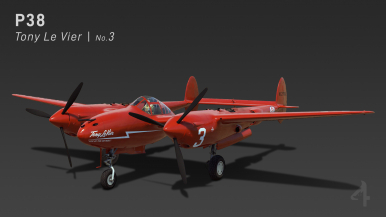

Aviation
P-38E
II
Rank
AB
2.7
RB
3.0
SB
3.3
Battle rating
USA
Research country
Fighter
Main role
9,200

Research
16,000

Purchase
General information
The P-38E is an American twin-engine fighter. It was introduced in Update 1.53 "Firestorm".
The P-38E is the first of the P-38 vehicles available in-game and is a very good plane. It gets an interceptor airspawn on most maps, which allows the P-38 to very often find itself above or at an equal altitude to its opponents. The main strength of the P-38E is its speed and energy retention, so it should be used accordingly - play it as an energy fighter or Boom 'n' Zoomer. The P-38E is also surprisingly manoeuvrable for such a large plane - while it can't outmanoeuvre single-engine fighters, it can put up a good fight.
Camouflages
Flight performance
Max speed
at 7,012 m
635595662612 km/h
Rate of Climb
13.510.517.210.5 m/s
Turn time
232521.924.1 s
Max altitude
12,192 m
Takeoff Run
380 m
Landing
flaps
flaps
Take-off
flaps
flaps
Combat
flaps
flaps
Air
brake
brake
General characteristics
Crew
1 person
Engine
Length
11.6 m
Wingspan
15.8 m
Wing Loading
227 kg/m²
Weight:
Base weight
6.16.295.946.26 t
Fuel in main tanks
0.82 t (1h 11m)
Limits:
Max Speed Limit (IAS)
790 km/h
Mach Number Limit
0.74 M
G limit
≈ -6/10 G
Flap Speed Limit (IAS)
L / T / C
250 / 495 / 566 km/h
Gear Speed Limit (IAS)
289 km/h
Offensive armament
20 mm AN/M2 cannon
Ammunition
150 rounds
Fire rate
600 shots/min
One-second Burst Mass
1.47 kg
| Belt | Belt filling | Armor penetration (mm) at a distance: | |||||
|---|---|---|---|---|---|---|---|
| 10 m | 100 m | 500 m | 1000 m | 1500 m | 2000 m | ||
| HEF-I/AP-T | 39 | 36 | 25 | 16 | 10 | 6 | |
| AP-T/AP-T/HEF-I/HEF-I | 39 | 36 | 25 | 16 | 10 | 6 | |
| HEF-I/HEF-I/HEF-I/AP-T | 39 | 36 | 25 | 16 | 10 | 6 | |
| AP-T/AP-T/AP-T/HEF-I | 39 | 36 | 25 | 16 | 10 | 6 | |
| HEF-I | 5 | 4 | 3 | 2 | 2 | 2 | |
4 × 12.7 mm M2 Browning machine gun
Ammunition
2,000 rounds
Fire rate
750 shots/min
One-second Burst Mass
0.54 kg
| Belt | Belt filling | Armor penetration (mm) at a distance: | |||||
|---|---|---|---|---|---|---|---|
| 10 m | 100 m | 500 m | 1000 m | 1500 m | 2000 m | ||
| T/Ball/Ball/I/AP-I | 28 | 26 | 18 | 11 | 7 | 4 | |
| AP-I/AP-I/AP-I/T/I | 28 | 26 | 18 | 11 | 7 | 4 | |
| T/AP/AP/AP/AP-I/I | 30 | 27 | 20 | 13 | 9 | 6 | |
| T/T/T/T/T/AP-I | 28 | 26 | 18 | 11 | 7 | 4 | |
| AP/AP-I/AP-I/I/I | 30 | 27 | 20 | 13 | 9 | 6 | |
Economy
Repair cost
Basic → Reference
AB
495 → 630 

RB
1,032 → 1,314 

SB
1,530 → 1,948 

Crew training
4,500 

Experts
16,000 

Aces
180 

Research Aces
190,000 

Reward multiplier
AB / RB / SB
30 / 80 / 150 % 

118 % 

Total cost of modifications
8,400 

9,390 

Talisman cost
640 

Flight performance | |
|---|---|
Survivability |
|---|
Weaponry |
|---|
Rating by players
You must play more than 3 battles for the last week and more than 10 battles in a vehicle to rate it.
Like:
32
Flight performance:
Not enough ratings
Survivability:
Not enough ratings
Aerial combat:
Not enough ratings
Ground attack:
Not enough ratings
Balance:
Not enough ratings
Tips & Tricks
This space is currently empty
Do you know any interesting vehicle features?
Loading...
No articles about this vehicle yet
Become the first author and get rewards!
Write a guide, tell about interesting historical facts, make a tutorial or simply an interesting post.
No more content
